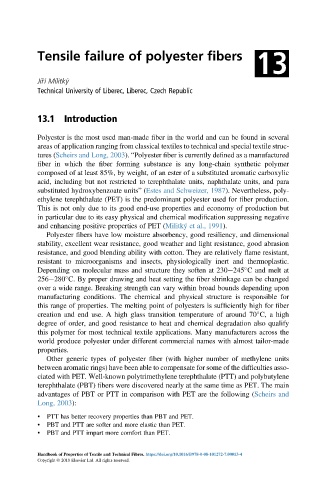Page 448 - Handbook of Properties of Textile and Technical Fibres
P. 448
13
Tensile failure of polyester fibers
Ji rí Militký
Technical University of Liberec, Liberec, Czech Republic
13.1 Introduction
Polyester is the most used man-made fiber in the world and can be found in several
areas of application ranging from classical textiles to technical and special textile struc-
tures (Scheirs and Long, 2003). “Polyester fiber is currently defined as a manufactured
fiber in which the fiber forming substance is any long-chain synthetic polymer
composed of at least 85%, by weight, of an ester of a substituted aromatic carboxylic
acid, including but not restricted to terephthalate units, naphthalate units, and para
substituted hydroxybenzoate units” (Estes and Schweizer, 1987). Nevertheless, poly-
ethylene terephthalate (PET) is the predominant polyester used for fiber production.
This is not only due to its good end-use properties and economy of production but
in particular due to its easy physical and chemical modification suppressing negative
and enhancing positive properties of PET (Militký et al., 1991).
Polyester fibers have low moisture absorbency, good resiliency, and dimensional
stability, excellent wear resistance, good weather and light resistance, good abrasion
resistance, and good blending ability with cotton. They are relatively flame resistant,
resistant to microorganisms and insects, physiologically inert and thermoplastic.
Depending on molecular mass and structure they soften at 230e245 C and melt at
256e280 C. By proper drawing and heat setting the fiber shrinkage can be changed
over a wide range. Breaking strength can vary within broad bounds depending upon
manufacturing conditions. The chemical and physical structure is responsible for
this range of properties. The melting point of polyesters is sufficiently high for fiber
creation and end use. A high glass transition temperature of around 70 C, a high
degree of order, and good resistance to heat and chemical degradation also qualify
this polymer for most technical textile applications. Many manufacturers across the
world produce polyester under different commercial names with almost tailor-made
properties.
Other generic types of polyester fiber (with higher number of methylene units
between aromatic rings) have been able to compensate for some of the difficulties asso-
ciated with PET. Well-known polytrimethylene terephthalate (PTT) and polybutylene
terephthalate (PBT) fibers were discovered nearly at the same time as PET. The main
advantages of PBT or PTT in comparison with PET are the following (Scheirs and
Long, 2003):
• PTT has better recovery properties than PBT and PET.
• PBT and PTT are softer and more elastic than PET.
• PBT and PTT impart more comfort than PET.
Handbook of Properties of Textile and Technical Fibres. https://doi.org/10.1016/B978-0-08-101272-7.00013-4
Copyright © 2018 Elsevier Ltd. All rights reserved.

